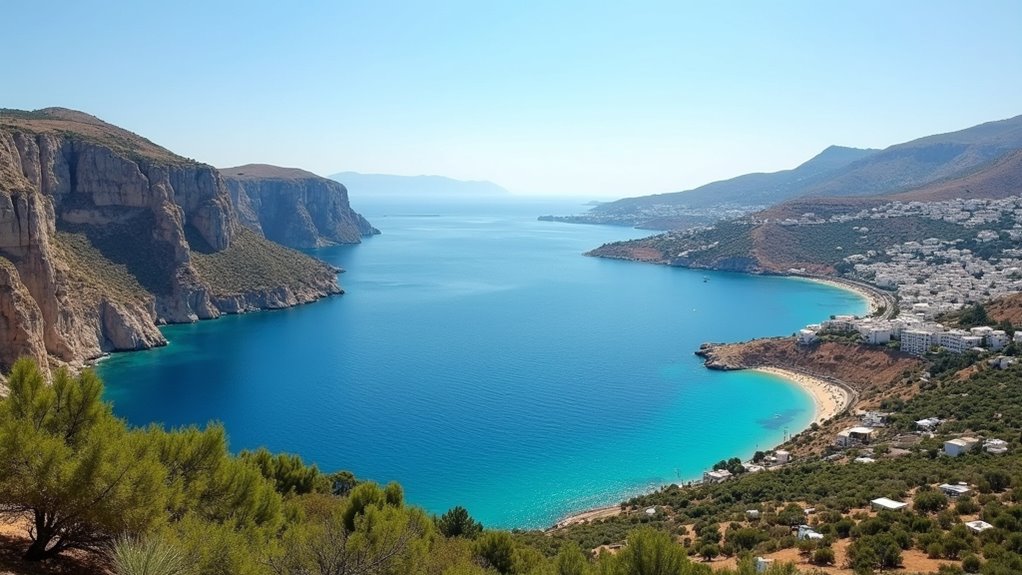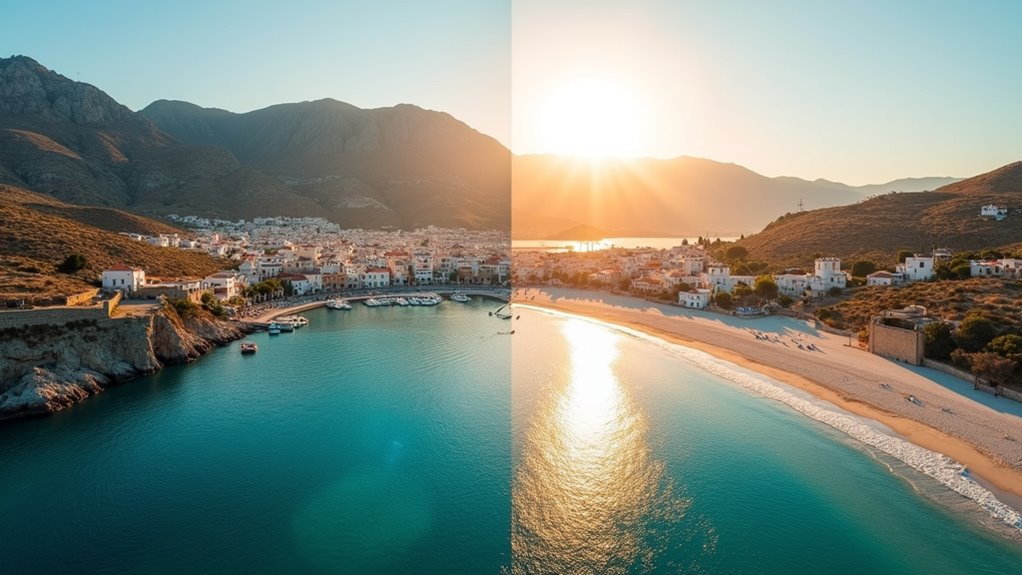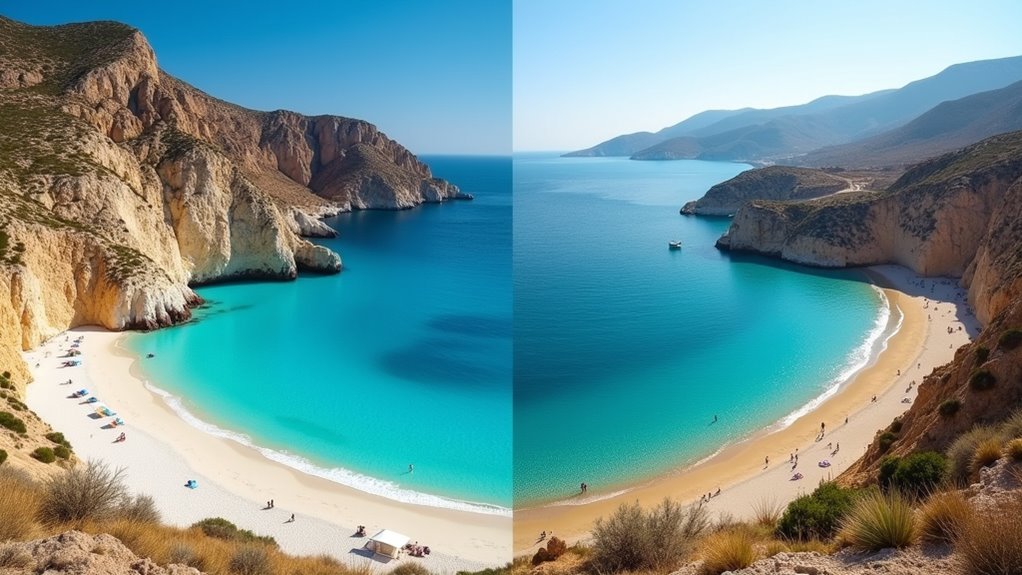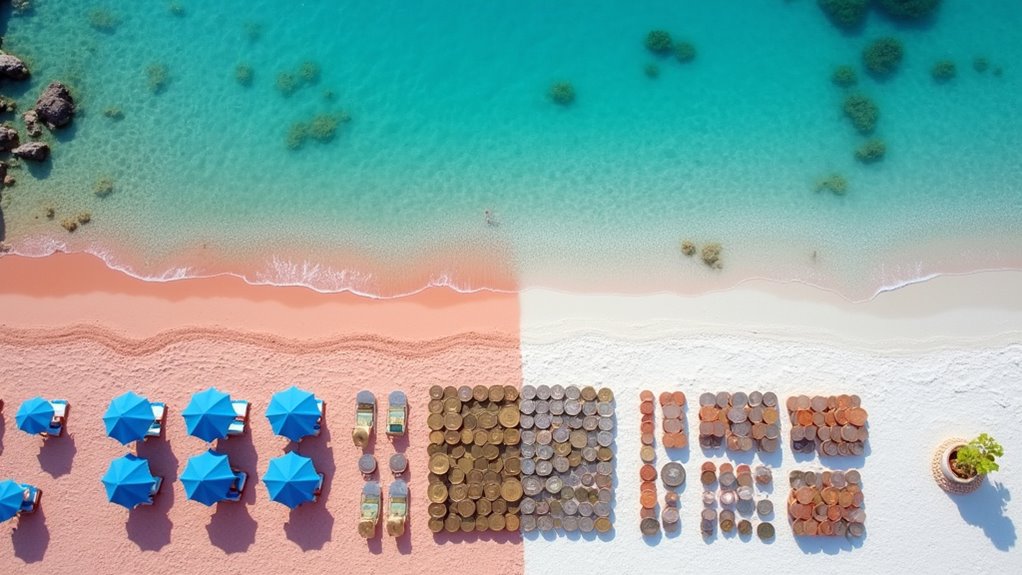Physical Address
304 North Cardinal St.
Dorchester Center, MA 02124
Physical Address
304 North Cardinal St.
Dorchester Center, MA 02124

Mediterranean magic awaits, but should you choose vast, versatile Crete or intimate, idyllic Naxos for your island escape?
Like two seductive sirens from ancient mythology, Crete and Naxos call to travelers with their distinct island charms. You’re facing a delightful dilemma that many Mediterranean-bound adventurers encounter. Both islands offer stunning beaches, fascinating history, and authentic Greek experiences—but they differ markedly in size, pace, and overall vibe. Your perfect Greek getaway depends entirely on what you value most in a vacation. Let’s explore what makes each island special and which might be your ideal match.

When deciding between Crete and Naxos for your Greek island getaway, you’re fundamentally choosing between a vast, diverse landscape and a more compact, intimate experience.
Crete offers impressive variety with its extensive coastline, numerous archaeological sites, and diverse terrain perfect for adventures. You’ll need a car and more time to explore this larger island, but you’ll be rewarded with affluent cultural experiences and varied beach options. Crete’s vibrant nightlife scene, particularly in Malia and Chania, provides entertainment options that cater to various preferences.
Naxos, meanwhile, delivers a more navigable, budget-friendly experience. It’s walkable in many areas, family-friendly, and offers a genuine slice of Greek life without requiring extensive planning. The island’s more modest size means you can experience its beaches, villages, and ancient ruins without complex logistics. For travelers concerned about costs, Naxos offers better value while still providing authentic Greek experiences.
Your choice ultimately depends on your travel style, budget, and how much ground you want to cover.
Understanding the physical dimensions of these Greek islands will dramatically impact your vacation experience. Crete, at 8,336 km², dwarfs Naxos‘s modest 428 km², creating fundamentally different travel experiences.
In Crete, you’ll need to plan your exploration more carefully. With a 1,046 km coastline and significant distances between attractions, renting a car is often necessary. Public transportation exists but can be time-consuming. Both islands offer unique opportunities to explore, and many visitors even find time to get tattoo souvenirs during their Greek adventures.
Naxos offers a more compact adventure. You can easily explore by foot or bike, with most attractions relatively close together. This smaller scale means less travel time and more experience time. As part of the Greek island group, Naxos provides excellent opportunities for island-hopping to nearby destinations.
Your choice depends on your vacation style: Crete delivers diverse landscapes and numerous cultural sites but requires more travel planning, while Naxos provides an intimate, easily navigable island experience.

Deciding how long to stay on each island can make or break your Greek vacation experience. For Crete, Greece’s largest island, plan at least 5-7 days minimum—three to four days simply won’t suffice to explore its diverse regions and opulent Minoan heritage.
Naxos, while smaller, still deserves at least three full days to properly enjoy its beautiful beaches, traditional mountain villages, and relaxed atmosphere. Consider adding extra time if you’re visiting during peak season when ferry schedules might be less flexible.
Your travel pace matters too—if you prefer leisurely mornings at cafés and unhurried exploration, add a day or two to these minimums. Naxos offers excellent opportunities for diving and culture enthusiasts, making it worth the extra time for these specific interests.
When planning an island-hopping itinerary, don’t forget to account for ferry travel time, which can consume several hours between destinations.
Families visiting Crete may want to allocate additional time to enjoy the island’s family-friendly resorts that offer dedicated children’s activities and beachfront accommodations.
Choosing between Crete and Naxos often comes down to which historical era fascinates you most. If you’re captivated by the Bronze Age Minoan civilization, Crete is your ideal destination. Don’t miss Knossos Palace, the legendary home of the Minotaur, or Phaistos Palace with its well-preserved ruins.
Meanwhile, Naxos offers impressive Cycladic treasures. The iconic Temple of Apollo (locally known as Portara) greets visitors arriving by ferry, while the Temple of Demeter reveals the island’s agricultural past. Naxos’s marble sculptures represent some of the finest Cycladic artistry. Both islands provide family-friendly attractions that make exploring ancient history accessible for travelers of all ages.
Both islands boast excellent museums. Heraklion Archaeological Museum houses an unparalleled Minoan collection, while Naxos Archaeological Museum displays local artifacts spanning thousands of years. Crete’s rich archaeological sites require at least one week to fully explore and appreciate their historical significance. Visit during off-peak seasons for a more intimate experience with these historical marvels.

When it comes to beach experiences, Crete and Naxos offer distinctly different coastal paradises that cater to various preferences.
Naxos wins for beach lovers seeking Caribbean-like sandy stretches without the crowds. You’ll find pristine waters and beaches extending up to 4km, many within walking distance from town. Saint George’s Beach near Naxos Town provides convenience with nearby tavernas. The island boasts over 12 miles of continuous golden sand beaches, including the popular Plaka area.
Meanwhile, Crete’s diverse coastline spans mountains, cliffs and sandy coves across its larger landscape. Rethymno offers lovely town beaches, though some beautiful spots require planning to reach. Both islands are considered among the best islands for snorkeling in Greece, with crystal clear waters perfect for underwater exploration.
If you’re after accessibility and natural beauty, Naxos is your best bet. For variety and a mix of landscapes, Crete delivers more options. Both islands feature beaches with sunbeds and facilities, but Naxos generally maintains a more unspoiled feel.
Regardless of which Greek island paradise you choose, understanding your transportation options is essential for maximizing your vacation experience.
In Crete, you’ll need to plan carefully due to its size. Car rental gives you freedom to explore remote mountain villages and beaches like Elafonisi, while KTEL buses connect major cities affordably. Heraklion’s airport and port serve as convenient gateways. The island hopping experience from Crete allows you to visit multiple nearby islands on day trips or longer excursions.
Naxos offers simpler navigation with compact dimensions. Buses reliably connect Naxos Town to popular beaches, while scooters and ATVs are perfect for adventurous travelers. The walkable Chora lets you easily access the Portara and Temple of Apollo on foot.
If island-hopping appeals to you, regular ferries connect Heraklion to Naxos in 3-4 hours, though service decreases in off-season. The Heraklion to Naxos ferry route operates daily during peak season from April to October, making summer an ideal time for island combinations.

Budget planning might be the least exciting part of your Greek island adventure, but it’s essential for enjoying your time without financial stress. Both Naxos and Crete offer affordable options if you know where to look.
In Naxos, budget accommodations start around $25-38 per night, while Crete offers similar pricing in its budget segment. For both islands, January through February provides the cheapest rates, with prices soaring during summer months. Booking at least 53 days in advance helps secure the best prices for your stay.
Save money by dining at traditional tavernas ($15-30 per meal) or shopping at local markets for self-catering. Take advantage of free beaches and hiking trails.
Museum entrance fees typically cost just €5-10.
While Naxos and Crete are reasonably priced, travelers should know that Corfu Island can be more expensive, especially in its luxury resorts and during peak season.
Book accommodations early, especially for high season visits, and consider traveling during shoulder seasons (April-May or September-October) for moderate prices with pleasant weather.
Now that you’ve sorted your finances, let’s match you with your ideal Greek island destination.
Choose Crete if you’re planning a longer trip (at least a week), enjoy road trips, and crave historical depth. With its international airport, diverse landscapes, and Minoan ruins, it’s perfect for history buffs and adventure seekers who don’t mind driving between attractions. Its beaches tend to be more volcanic ash/grit in nature, reflecting the island’s geological character.
Naxos is your match if you prefer a compact, spontaneous experience. Its manageable size makes it ideal for shorter stays (3-4 days) with easy access to beaches, mountain villages, and local culture. You’ll enjoy authentic interactions with locals and a more relaxed pace. For travelers seeking additional options, consider Kefalonia’s allure with its stunning landscapes and intimate atmosphere.
Consider your travel style: Are you a systematic planner who wants variety and scale (Crete), or do you seek an intimate island experience with minimal logistics (Naxos)?
Whether you’ll thrive on Crete’s sprawling canvas of history or Naxos’s intimate charm depends on your travel heartbeat. Picture Crete as an epic novel waiting to be devoured over weeks, while Naxos is a perfect short story you can savor in days. Let your budget, itinerary flexibility, and adventure appetite guide you. Remember, there’s no wrong choice—just different flavors of Greek paradise tailored to your unique travel palate.